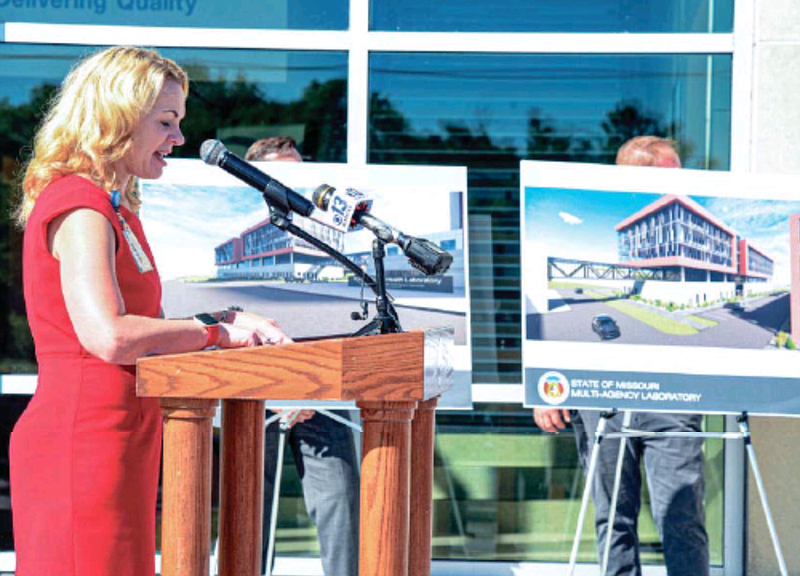The new state Health and Crime Lab coming to Jefferson City is a blueprint for multi-agency collaboration, state leaders said.
Gov. Mike Parson and state agency leaders on Thursday announced details of the new Health and Crime Lab to be built next to the State Health Lab on North Chestnut Street in Jefferson City. The property sits across the street from the historic Missouri State Penitentiary.
The 260,000-square-foot lab will house five state agencies, including the Department of Health and Senior Services, Department of Natural Resources, Department of Agriculture, Department of Conservation and the Missouri Highway Patrol.
Parson said cooperation among the state agencies on the project is a shining example of what the state needs to do more of in the future.
"It's going to be a one-stop-shop, and it's going to make us do better," he said. "I think a lot of things we don't get out in a timely fashion simply because we don't have the space to do it or we don't have the ability to do it. I want to change that. I want to make sure we provide the services for the state of Missouri, for the people of this state."
The $183 million project -- funded through state appropriations of federal American Rescue Plan Act dollars -- includes the construction of the new multi-story lab, expansion of the existing State Health Lab and a parking lot to serve both facilities.
"To say we are excited is an understatement," DHSS Deputy Director Laura Naught said. "This started as a dream a little over a year ago at the height of the COVID-19 pandemic right in this very building when we were working across agencies to figure out how to meet Missouri's current and future laboratory needs."
Naught said the investment is transformative to the state's laboratory infrastructure.
Cooperation among agencies will deliver comprehensive and rapid lab services, Naught said. Specifically for DHSS, she said the development will enhance training for hospital lab workers, expand life-saving newborn testing, improve public health environmental testing and add next generation molecular testing.
"This innovative effort will be the first of its kind to address today's evolving world and prepare us for the emerging diseases and contaminant threats," Naught said.
MDC Deputy Director Aaron Jeffries said the new facility will further cross-agency collaboration spurred by the pandemic and help to identify and address new potential threats.
"I look at this and this is all about collaboration," Jeffries said.
MDC will primarily be using the facility to research big game species, such as black bear and elk, and other species, ranging from hellbender salamanders to migrating waterfowl.
DNR will be using the facility for its Environmental Services Program, which will be relocated from its existing lab in Jefferson City once the new lab is complete. Environmental Services conducts air and water quality monitoring, chemical analysis and emergency environmental response.
DNR Director Dru Buntin said the team's current facility is more than 30 years old and limits what operations staff can perform.
"This one health laboratory campus will greatly expand our capabilities, our infrastructure, it'll allow us to more effectively staff the 24-hour spill line," Buntin said.
MDA Director Chris Chinn said the laboratory is also a win for farmers and ranchers in the state because it will house testing that determines disease-prevention practices on farms.
"The central location in Jefferson City is key to Missouri veterinarians who deliver livestock samples here to be tested," Chinn said. "Those same accredited veterinarians can also pick up supplies and forms necessary to continue their operations."
Agricultural researchers conduct diagnostic, surveillance and pre-movement testing for several species out of the existing State Health Lab. Once the new facility is complete, the Animal Health Lab will be moved there, giving DHSS expanded space in the State Health Lab.
Parson said the lab investment is long overdue and it will improve Missouri's services to residents and make the campus a better place to work for employees.
"I've said all along I want to invest in the future of this state," Parson said. "It's not about a one year and be done. It's about what are we going to do to make it better."
Sandy Karsten, director of the Missouri Department of Public Safety, said the crime lab will be an important development for victims of crime in Missouri.
The lab will house the Highway Patrol's DNA analysis for sexual assault cases, toxicology testing and fingerprint analysis for violent and non-violent crimes.
Karsten said the lab will better equip the patrol to serve several hundred law enforcement agencies that depend on it to conduct forensic testing.
The Highway Patrol received more than 29,100 cases from more than 600 agencies last year, Highway Patrol Superintendent Eric Olson said. Approximately 85 percent were local law enforcement agencies in the state. Olson said the crime lab will serve as a regional research facility to be used in conjunction with state and regional partners, as well as colleges and universities to research forensic technology.
"From assisting in criminal cases to researching new scientific methods, there will be a real and measurable impact on the citizens and the communities that we serve," he said.
The Highway Patrol is moving all operations from the crime lab at its General Headquarters to the new campus once it's complete, and the old lab at the headquarters will be used to consolidate off-site operations, among other Patrol functions, said Brian Hoey, director of the crime lab.
Preliminary plans for the new lab campus left off the Highway Patrol. Naught said the agency was added after the state reviewed the viability of land and determined it would be more efficient to combine all of the labs together.
The Missouri Office of Administration is in the process of selecting a design consultant, which should be done before the fall. The building design is expected to take 18 months and construction is scheduled to begin by mid-2024 for a complete campus before the end of 2026.

